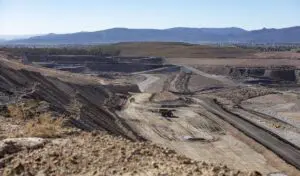US aluminium giant Alcoa has rekindled fears that the huge smelter in Portland in Victoria may close, a potential victim of the global shift to clean and cheaper power.
In a decision that raises fears about the future of Australia’s other big smelters, Alcoa this week flagged asset sales of around $1 billion and a portfolio review as it sought to reduce its asset base in the face of plunging metals prices.
One of the chief criteria for any decisions, CEO Roy Harvey noted, was the level of emissions – and Portland, which has a contract with the Loy Yang A brown coal generator, is at the wrong end of the scale. Alcoa sources 85 per cent of its energy from renewables (mostly hydro), and seeks to have the lowest CO2 emissions, and Portland’s emissions-intensive energy supply blows that plan out of the water.
A potential closure of the Portland smelter would have huge ramifications for the Australian grid.
It would remove the biggest customer of brown coal, and ironically accelerate the transition to clean energy that it cannot afford to wait for – unlike other projects (Oz Minerals, Fortescue, Element25) and several big renewable hydrogen mega projects which are looking to build their business case around cheap wind and solar.
As ITK analyst and RenewEconomy contributor David Leitch writes below, the closure of Portland is inevitable. It should probably have happened years ago, but in a deal with the Victoria government it stayed open. The details of that deal have not been released, but because of its impact on electricity prices, it’s likely to be costing other customers – residential and business – up to $1 billion a year.
That is a massive cross-subsidy. Coal generators and big customers have had a symbiotic relationship in the Australian energy market, and if Alcoa – and others – go then it will likely accelerate the exit of the big coal generators.
Little wonder, then, that the AFR was reporting on Friday that the coal generators were demanding of the federal government to get three years’ notice of closure of any smelters, in an ironic twist on the new government rules of advice about potential coal closures.
ITK analyst David Leitch takes the story from here, with this analysis:
Aluminium is a great product, every Australian has a use for it and global demand is still growing – and if it wasn’t aluminium it might be the equally energy intensive data centre, or cryptocurrency mining.
These products are all energy intensive.
Australia’s energy challenge is to maximise its opportunity as the world pivots on energy. The transition is relatively long, say 15-30 years, and the end point is uncertain.
The question is how to bring existing and new industries along for the ride in a world where corporate management make global decisions about long-term competitiveness. Other than subsidies, as old as time itself as a means of attracting manufacturing and jobs, where does Australia stand today and where will it stand post transition?
Is it worth subsidising old industries indefinitely in the hope that things will be better some day?
The answer is that plans, industry by industry and for the economy, need to be better than they have been. Federal energy policy has been a disgrace for many years, wherever you look.
You can talk about gas reservation, only discussed years after the horse had bolted on carbon and electricity policy, but wherever you look, whatever shade of government, the long-term planning and execution is shocking. But then what else is new? Only every 20 or 30 years is there a federal government policy with any long-term impact.
That’s why the Hawke government or Howard’s gun control policies are so memorable. They are by far the exceptions.
Portland smelter’s hidden subsidy is probably around $1 billion per year
Back in 2016, we wrote here at Reneweconomy when the Andrews government announced support to keep the Portland smelter open, that the largest cost to taxpayers and consumers was not the $240 million of explicit subsidy. Rather it was the notional $5/MWh it added to wholesale electricity prices.
Spread over 200TWh (rough as) of NEM-wide consumption that was about $1 billion a year.
We wrote that in the context of very rapidly rising electricity futures pricing as the market adjusted to two unexpected pieces of news.
(1) Hazelwood was closing when it was expected to stay open; and (2) Portland was staying open when it was expected to close.
Those two things added up to a 15TWh change in the demand/supply balance in the NEM and in Victoria and it’s a situation that impacts Victorian electricity prices to this day.
Victoria’s metered demand in the past 12 months is 43TWh, so that was broadly a one-third swing in the balance. No wonder the price has jumped about.
That said, even if Portland stays open things are going to improve in Victoria as new supply, not just in the State but also in Tasmania and South Australia, continues to come on line.
There are still major wind farms in Victoria – e.g. Stockyard Hill and Moorabol (800MW between them) – due in the next six-to-nine months.
The bigger point now, totally accepted by all, is that each coal station – there are just eight south of the Queensland border – represents a step change to supply. Each power station is, say, 5%-10% of relevant supply. That’s why there is such an emphasis on managing exits.
Equally, aluminium has historically been the largest source of electricity demand in Australia, at one stage accounting for around 12 per cent of consumption.
However the closure of Kurri Kurri in NSW, Point Henry in Victoria, and reduced output from Boyne Island in Queensland has reduced that share.
Each of the major smelters in Australia has had a “sweetheart” electricity deal of one sort or another. In the end the state governments have tired of these deals, or in NSW’s case their hand has been forced by privatisation.
In aluminium’s case there are broadly three inputs which determine global cost competitiveness: alumina, labour/other, and electricity.
Of those, the alumina cost is broadly equal for most smelters round the world, and to an extent so are the labour/other costs. It is true that labour/other costs are impacted by scale economies.
This means that the main differentiator of where you sit on the cost curve is the electricity cost.
The electricity cost, itself, has two dimensions. One is the efficiency of the smelting process, where the primary driver is age – older smelters use more energy to make a tonne of aluminium and the other is the price of the power.
From a global perspective, and looking at generation costs, the advantaged regions are Canada and Russia, which have large hydro resources – Russia in particular has, I believe, scope to build more; and the middle East and the USA, which have cheap gas.
The majority of the world’s aluminium production runs on coal, though, and basically much of the coal is priced at the global margin.
That is, what you pay in China isn’t all that different to what you pay in Australia.
Public perceptions of high global electricity prices, fuelled by politicians reflect (1) prices in Australia have risen sharply in response to (a) higher coal and gas costs and (b) a tighter balance between supply and demand; and (2) transmission and distribution costs which in long distance, thinly populated Australia are more impactful.
Of course, it’s the exceptions that prove the rule and there is no doubt that much aluminium in China and probably India is produced by smelters with captive power stations and coal mines where ITK believes compliance with environmental policy is not always the foremost consideration.
But new smelters even in China don’t find it so easy.
Some smelters in China have had to close down due to environmental non-compliance and getting permission for new smelters is difficult. So in China some firms are trying to move production from coal-intensive Shandong to hydro-rich areas.
Of course, in aggregate, this does nothing but it may improve the story an individual smelter tells.
The global cost curve looks as follows:

Note how flat the curve is and how close the majority of production is to the aluminium price.
Given this global context what about Portland?
The first thing to understand is that even with all its subsidies Portland loses money at the ebitda level.
The following is an extract from AWC’s latest half-yearly report. As far as I know these are the only financials publicly available:

Obviously losses would be higher without the Victorian government support. The exact form of support I don’t know.
AGL is the electricity supplier, and whether it charges a market price and then the Victorian government offsets that, or how it works is “confidential”. In my opinion, there is a case for putting it all in the open so that the consequences can be better seen and understood by the broader group of stakeholders.
Nothing breeds distrust like secrecy, but I might as well save my breath.
The obvious question is what is the point?
Portland’s owners, the electricity-paying public and the Victorian government, are keeping the business going as a public service. Other than the workers and the benefits to the local economy there is no point. It’s just a charity.
The smelter uses, I believe, an older technology (not sure when its last update was); is not particularly scale efficient and has about zero comparative advantage.
Regarding the carbon intensity of Portland, that is dropping quickly. It’s not the individual generator that has the contract, LYA in this case, but the Victorian average.
Right now, brown coal is 68 per cent of Victorian supply, down from 75 per cent a year ago, and will drop much further over the next few years.
The Boyne Island and Tomago smelters may not be as badly off as Portland but they certainly have their issues.
Here at ITK we have our own views on how things might be moved forward but above all it would be nice to see some serious long-term planning given to the issue.
If you want to talk global head office management into supporting your industry you need to show them a long-term plan they can buy into.
By and large, for an aluminum smelter, the individual pots have, say, a six-year life. So if you don’t think you have good long-term prospects six years ahead of time, you stop replacing the those pots as they wear out, 1/6 of the pots every year.
Unit reductions in demand are half as important as reductions in supply
By and large, closing an aluminum smelter has less impact on the supply/demand balance as closing a coal station. Yallourn, for instance, has 9.6TWh of supply compared to Portland at around 5TWh (maybe less now?) of demand. But it’s still significant.
The closure of Kurri Kurri and Point Henry smelters contributed to a fall in NEM demand that in turn lead to the closure of Wallerawang, Northern power stations and was probably a factor in the Hazelwood decision.
So this is something to consider.
I’d go as far as saying that closure of Portland would very materially increase the chances of an early Yallourn closure.
In the long-term that’s a “good” thing, as Yallourn has to go from a carbon perspective. But as experience shows, the Victorian government and AEMO will need to be on their toes and fully prepared.
As ever, this means pushing on, among other things, with more transmission development.










